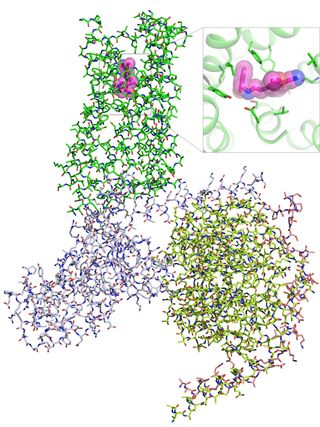Psychedelic-Assisted Therapy
This Is Your Brain’s 5-HT2A Receptors on LSD or Psilocybin
Scientists pinpoint how psychedelic drugs bind to 5-HT2A serotonin receptors.
Posted September 17, 2020 Reviewed by Matt Huston
Serotonergic psychedelics, such as psilocybin and LSD, are also commonly referred to as hallucinogens because at higher "trip-inducing" doses (as opposed to microdoses), these drugs typically trigger hallucinations.
For about a decade, researchers have suspected (Kometer et al., 2013) that the psychedelic, hallucinogenic effect of these drugs is related to how psychotropic compounds bind with 5-HT2A serotonin receptors.
Accumulating evidence also suggests that 5-HT2A receptors are the core reason psychedelic therapies continue to show promise as a "Breakthrough Therapy" for helping patients with treatment-resistant depression. Last year, a Neuropsychopharmacology paper (Madsen et al., 2019) reaffirmed that when the primary psychoactive ingredient in magic mushrooms binds with 5-HT2A receptors, it triggers psilocybin-induced psychedelic experiences. However, until now, structural biologists haven't been able to map precisely how serotonergic hallucinogens bind with serotonin 2A receptors on a molecular level.

This week, Bryan Roth of the University of North Carolina's Department of Pharmacology and Georgios Skiniotis of Stanford University's School of Medicine, along with their colleagues, published groundbreaking research that used cryogenic electron microscopy (cryo-EM) to illustrate precisely how psychedelic compounds bind to the 5-HT2A serotonin receptor complex. These findings (Kim et al., 2020) were published on Sept. 17 in the journal Cell.
According to the authors, this research "sets the stage for the discovery of new kinds of antidepressants, anti-anxiety drugs, and treatments for substance use disorders." These findings could also help to explain the underpinnings of hallucinogen-persisting perception disorder (HPPD).
In a news release, Roth spotlights the challenging work undertaken by co-first author Kuglae Kim, a postdoctoral fellow in the Roth Lab: "Over three years in a deliberate, iterative, creative process, he was able to modify the serotonin protein slightly so that we could get sufficient quantities of a stable protein to study."
"A combination of several different advances allowed us to do this research," Skiniotis added. "One of these is better, more homogeneous preparations of the receptor proteins. Another is the evolution of cryo-electron microscopy technology, which allows us to view very large complexes without having to crystalize them."
What is cryo-EM? Cryo-electron microscopy is a "revolutionary technique" (Callaway, 2020) that allows structural biologists to create 3D images of proteins and other molecular structures. Earlier this year, Skiniotis and his colleagues published a paper announcing that they'd developed a pipeline for robust modeling of ligands into "cryo-EM maps."
Bryan Roth is project director of the NIMH's Psychoactive Drug Screening Program (PDSP) at UNC-Chapel Hill. In June 2020, Roth's Lab announced a $26.9 million cooperative agreement with the Defense Advanced Research Projects Agency (DARPA) to develop a new class of psychiatric drugs for the treatment of addiction, anxiety, or depressive symptoms.
"Depression, anxiety, and substance abuse affect large segments of the population. Creating safe, rapidly acting, and more effective medications would revolutionize the treatment of these disorders, thereby diminishing death and disability," Roth said in a June 16 news release. "Although drugs like ketamine and potentially psilocybin have rapid antidepressant actions, their hallucinogenic, addictive, and disorienting side effects make their clinical use limited."
Creating high-resolution cryo-EM maps that show psychedelic compounds' chemical architecture when they're actively bound to the 5-HT2A serotonin receptor opens the door to eliminating psychedelic drugs' hallucinogenic properties without losing their strong therapeutic effects.
"Gaining this first glimpse of how [psychedelics] act at the molecular level is really important, a key to understanding how they work," Roth noted. "Given the remarkable efficacy of psilocybin for depression (in Phase II trials), we are confident our findings will accelerate the discovery of fast-acting antidepressants and potentially new drugs to treat other conditions, such as severe anxiety and substance use disorder."
"The more we understand about how these drugs bind to the receptors, the better we'll understand their signaling properties," Skiniotis concluded. "This work doesn't give us the whole picture yet, but it's a fairly large piece of the puzzle."
References
Kuglae Kim, Tao Che, Ouliana Panova, Jeffrey F. DiBerto, Jiankun Lyu, Brian E. Krumm, Daniel Wacker, Michael J. Robertson, Alpay B. Seven, David E. Nichols, Brian K. Shoichet, Georgios Skiniotis, Bryan L. Roth. "Structure of a Hallucinogen-Activated Gq-Coupled 5-HT2A Serotonin Receptor." Cell (First published: September 17, 2020) DOI: 10.1016/j.cell.2020.08.024




